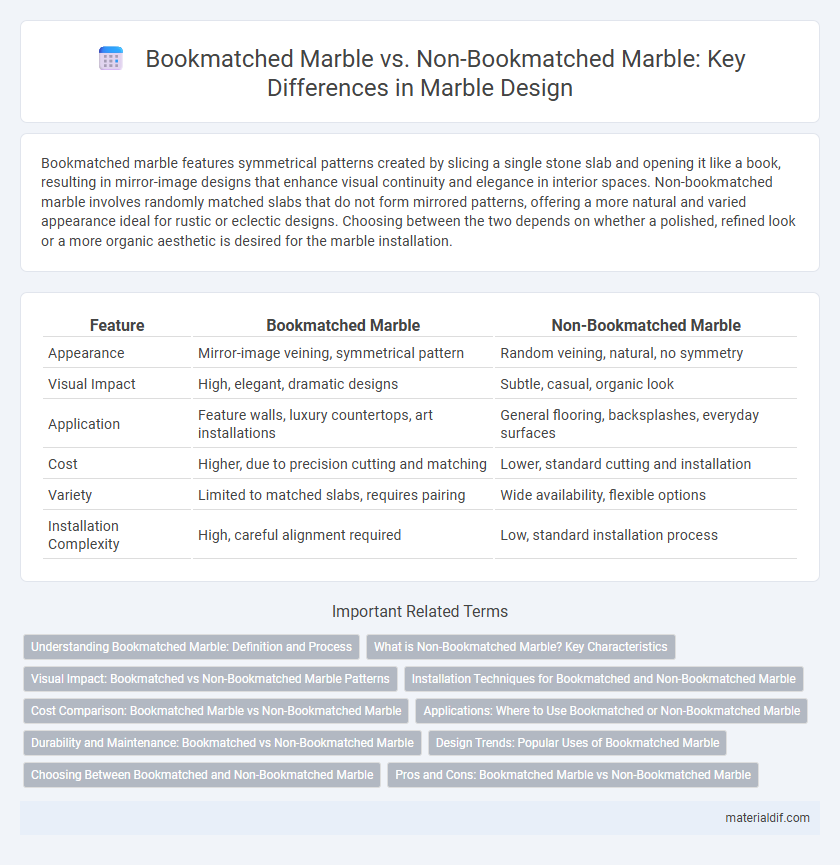Bookmatched marble features symmetrical patterns created by slicing a single stone slab and opening it like a book, resulting in mirror-image designs that enhance visual continuity and elegance in interior spaces. Non-bookmatched marble involves randomly matched slabs that do not form mirrored patterns, offering a more natural and varied appearance ideal for rustic or eclectic designs. Choosing between the two depends on whether a polished, refined look or a more organic aesthetic is desired for the marble installation.
Table of Comparison
| Feature | Bookmatched Marble | Non-Bookmatched Marble |
|---|---|---|
| Appearance | Mirror-image veining, symmetrical pattern | Random veining, natural, no symmetry |
| Visual Impact | High, elegant, dramatic designs | Subtle, casual, organic look |
| Application | Feature walls, luxury countertops, art installations | General flooring, backsplashes, everyday surfaces |
| Cost | Higher, due to precision cutting and matching | Lower, standard cutting and installation |
| Variety | Limited to matched slabs, requires pairing | Wide availability, flexible options |
| Installation Complexity | High, careful alignment required | Low, standard installation process |
Understanding Bookmatched Marble: Definition and Process
Bookmatched marble refers to two slabs of marble cut from the same block and polished to create mirror images when placed side by side, enhancing visual symmetry and artistic appeal. The process involves splitting a single marble block into slabs and opening them like a book to reveal matching veins and patterns, resulting in a striking, continuous design often used in luxury interiors. Unlike non-bookmatched marble, which features randomly matched slabs, bookmatched marble offers a more cohesive and harmonious aesthetic, ideal for feature walls, countertops, and bespoke architectural elements.
What is Non-Bookmatched Marble? Key Characteristics
Non-bookmatched marble refers to marble slabs that are not paired or mirrored to create a symmetrical pattern, resulting in a more random and unique appearance. Key characteristics include varied veining and color distribution without repetitive symmetry, offering a natural and organic aesthetic. Non-bookmatched marble is ideal for designs where individuality and variation are preferred over uniformity.
Visual Impact: Bookmatched vs Non-Bookmatched Marble Patterns
Bookmatched marble creates a striking visual impact by mirroring stone veins and colors across adjacent slabs, producing a symmetrical, butterfly-wing pattern that enhances the aesthetic appeal of walls and floors. Non-bookmatched marble features random, unaligned patterns that highlight the natural diversity of the stone but lack the deliberate symmetry found in bookmatching. The choice between bookmatched and non-bookmatched marble significantly influences design focus, with bookmatching offering a dramatic centerpiece and non-bookmatching providing a more organic, varied texture.
Installation Techniques for Bookmatched and Non-Bookmatched Marble
Bookmatched marble installation requires precise alignment of veining patterns, typically involving careful layout planning and skilled cutting to ensure symmetrical mirror-image slabs meet seamlessly. Non-bookmatched marble installation offers more flexibility, allowing installers to focus on consistent grout lines and balanced aesthetics without the necessity of matching veins, often simplifying the cutting and placement process. Both techniques demand expertise in handling marble slabs to prevent damage and maintain structural integrity during installation.
Cost Comparison: Bookmatched Marble vs Non-Bookmatched Marble
Bookmatched marble typically incurs higher costs due to the precise cutting and matching process required to create symmetrical patterns, which increases labor and material wastage. Non-bookmatched marble is generally more affordable as it allows for more flexible, less restrictive installation without the need for pairing specific slabs. Cost differences can range from 20% to 50%, depending on slab rarity and complexity of the bookmatching technique used.
Applications: Where to Use Bookmatched or Non-Bookmatched Marble
Bookmatched marble is ideal for feature walls, large tabletops, and fireplace surrounds where symmetrical patterns enhance visual impact and luxury. Non-bookmatched marble suits flooring, bathroom walls, and kitchen backsplashes where natural, varied veining adds character without the need for perfect symmetry. Both finishes elevate interiors but choosing depends on whether a bold, mirrored design or organic, unique patterning aligns with the project's aesthetic goals.
Durability and Maintenance: Bookmatched vs Non-Bookmatched Marble
Bookmatched marble features perfectly aligned veining that enhances the visual appeal but can reveal imperfections more easily, requiring careful sealing to maintain durability. Non-bookmatched marble offers more variation in patterns, which can better conceal wear and minor stains, potentially reducing the frequency of maintenance. Both types demand regular cleaning and sealing, but bookmatched slabs may need more meticulous upkeep to preserve their pristine appearance.
Design Trends: Popular Uses of Bookmatched Marble
Bookmatched marble creates symmetrical patterns by pairing two adjacent slabs, enhancing visual impact in luxury interior design, commonly used for feature walls, countertops, and flooring. Non-bookmatched marble offers a more natural, random veining pattern, preferred for subtle, organic aesthetics in residential and commercial spaces. Current design trends favor bookmatched marble in high-end projects for its dramatic and artistic appeal, elevating spaces with bold, mirror-image motifs.
Choosing Between Bookmatched and Non-Bookmatched Marble
Bookmatched marble showcases mirrored veining patterns created by slicing a marble block into consecutive slabs, enhancing visual symmetry and dramatic aesthetics in interior design. Non-bookmatched marble offers a more natural, random veining appearance, ideal for subtle elegance or organic design schemes. Selecting between bookmatched and non-bookmatched marble depends on the desired visual impact, budget considerations, and the architectural context of the installation.
Pros and Cons: Bookmatched Marble vs Non-Bookmatched Marble
Bookmatched marble features symmetrical, mirror-image patterns created by slicing a single slab, offering a visually striking and luxurious aesthetic ideal for statement walls and countertops. Non-bookmatched marble provides a more varied, natural appearance with random veining, which can be easier to source and install while reducing costs. While bookmatched marble enhances design coherence and elegance, it requires precise cutting and higher expenses; non-bookmatched marble offers more flexibility and budget-friendliness but lacks the dramatic visual impact of bookmatching.
Bookmatched Marble vs Non-Bookmatched Marble Infographic

 materialdif.com
materialdif.com